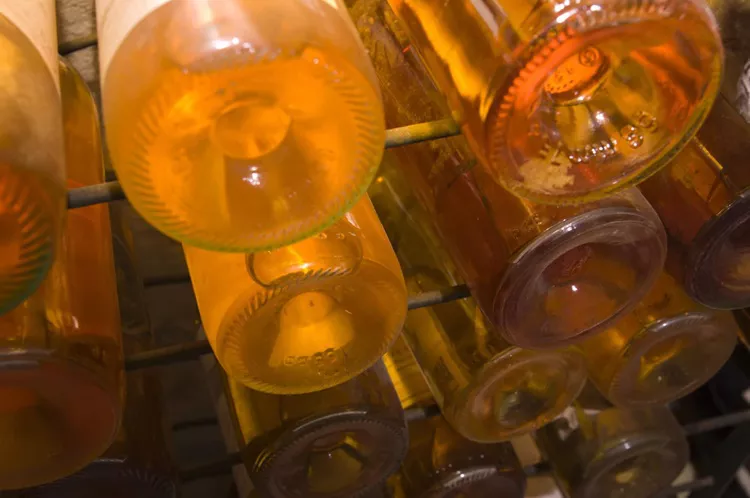Sauternes is one of the world’s most revered dessert wines, known for its honeyed sweetness, vibrant acidity, and rich, complex flavors. Originating from the Sauternais region in Bordeaux, France, this golden nectar is made from a combination of grapes that have been affected by “noble rot” (Botrytis cinerea). This guide will take you through the step-by-step process of making Sauternes, explaining the history, the types of Sauternes wine, the essential techniques involved, and a potential Sauternes Wine Substitute in case you’re looking for alternatives to this decadent delight.
The Origins of Sauternes Wine
The history of Sauternes dates back centuries, with records suggesting that the wine’s signature method of production was refined in the 18th century. The region’s unique terroir, combining the warmth of the Garonne River and the cool morning mists, is perfect for encouraging the growth of noble rot. The noble rot is a form of mold that concentrates the sugars in the grapes, creating a complex, sweet wine that balances richness with refreshing acidity.
Sauternes Wine Types
When it comes to Sauternes, there are several types, each offering different flavor profiles. The primary grape varieties used are Sémillon, Sauvignon Blanc, and Muscadelle. The most common Sauternes wines come from classified estates, including Château d’Yquem, which is considered the pinnacle of Sauternes wine production.
Some common Sauternes Wine Types include:
Château d’Yquem – The finest example of Sauternes, known for its rich complexity and aging potential.
Château Climens – Known for its pure, floral characteristics and vibrant acidity.
Château Suduiraut – A balanced wine with notes of honey, apricot, and citrus.
Doisy-Daëne – A wine that offers both freshness and richness, with a beautiful texture.
Step-by-Step Process of Making Sauternes Wine
Making Sauternes is a delicate and intricate process that requires patience, skill, and optimal growing conditions. Below is a breakdown of the key steps involved:
1. Vineyard Selection and Grape Harvesting
The first step in making Sauternes is selecting the right vineyard. The soil, climate, and proximity to the Garonne River all play a critical role in the development of noble rot. Once the grapes have ripened to the correct level of sugar content, they are harvested in multiple passes, allowing winemakers to select only the grapes that have been affected by Botrytis cinerea. This ensures that the final wine will have the signature sweetness and complexity.
2. Fermentation
Once the noble-rot grapes are harvested, they are carefully pressed to extract the juice, which is then fermented. Fermentation takes place in oak barrels or stainless steel tanks, depending on the winemaker’s preferences. This process can take several weeks, during which the yeast converts the sugars into alcohol. The fermentation process is slowed due to the high sugar content, which results in a higher alcohol content after completion.
3. Aging
After fermentation, the wine is aged in barrels for a period of time, typically between 12 to 24 months. During aging, the wine gains complexity, and its flavors evolve. The contact with the oak barrels imparts additional layers of flavor, such as vanilla, toast, and spice. This aging process is crucial for developing the signature characteristics of Sauternes, such as its creamy texture and depth of flavor.
4. Bottling and Enjoying
Once the wine has matured in the barrels, it is bottled and ready to be enjoyed. Sauternes is often bottled in smaller formats due to its rich, concentrated nature. The wine can be enjoyed immediately after bottling or can be aged for decades, during which it continues to develop more complexity and nuance.
Sauternes Wine Substitutes
If you’re looking for a Sauternes Wine Substitute for a particular recipe or occasion, there are several alternatives that can offer a similar flavor profile. Some options include:
Tokaji Aszú – A Hungarian dessert wine made from botrytized grapes, known for its honeyed sweetness and acidity.
Ice Wine – Produced from grapes that freeze on the vine, ice wine is also a sweet, fruity wine that can mimic the sweetness of Sauternes.
Late Harvest Wines – Wines made from late-harvested grapes, often with similar sweetness and rich flavor as Sauternes.
Muscat – Known for its floral and sweet profile, Muscat wines can also serve as a reasonable alternative to Sauternes in certain dishes.
Conclusion
Making Sauternes is both an art and a science, requiring specific conditions, patience, and a deep understanding of the winemaking process. The unique combination of Sémillon, Sauvignon Blanc, and Muscadelle grapes, along with the influence of noble rot, gives Sauternes its distinctive character. Whether you are a winemaker looking to create your own version of this iconic wine or a wine enthusiast seeking to appreciate its complexities, understanding the production process and different Sauternes wine types will enrich your knowledge and enjoyment of this legendary dessert wine.
With the tips and information provided in this guide, you can delve deeper into the world of Sauternes and, perhaps, even explore some alternative wine substitutes to bring new flavors into your wine collection or cooking ventures.
You Might Be Interested In:


